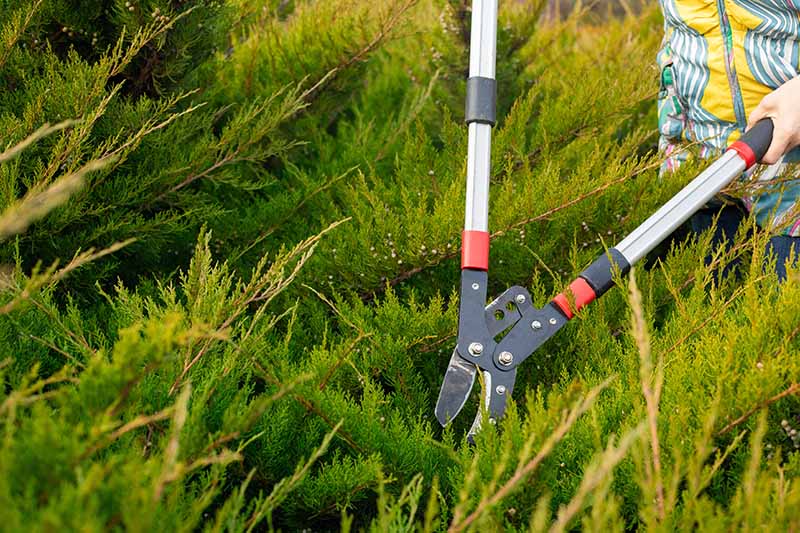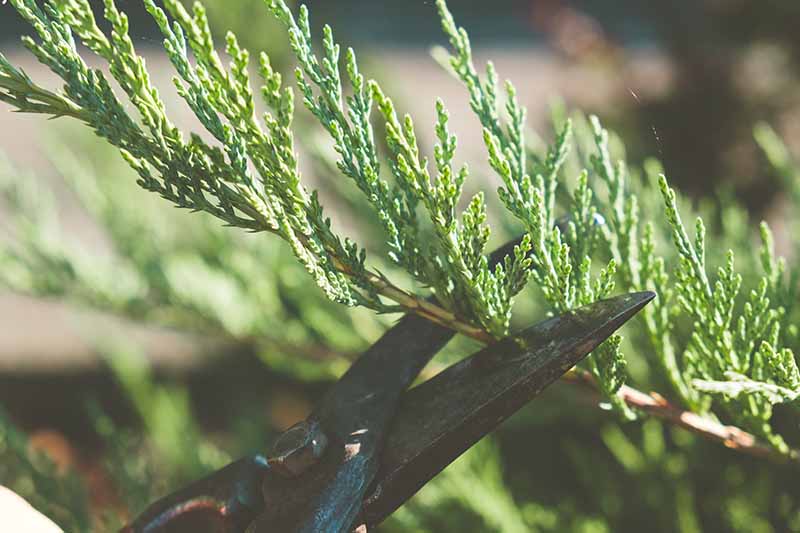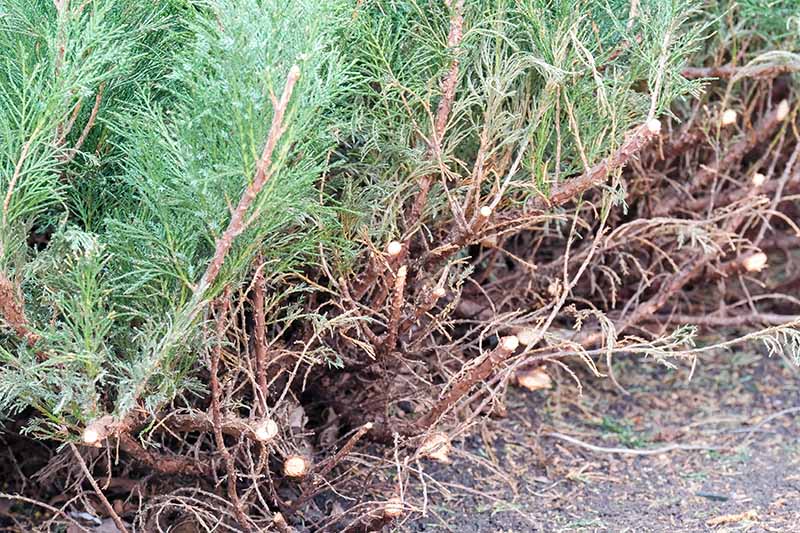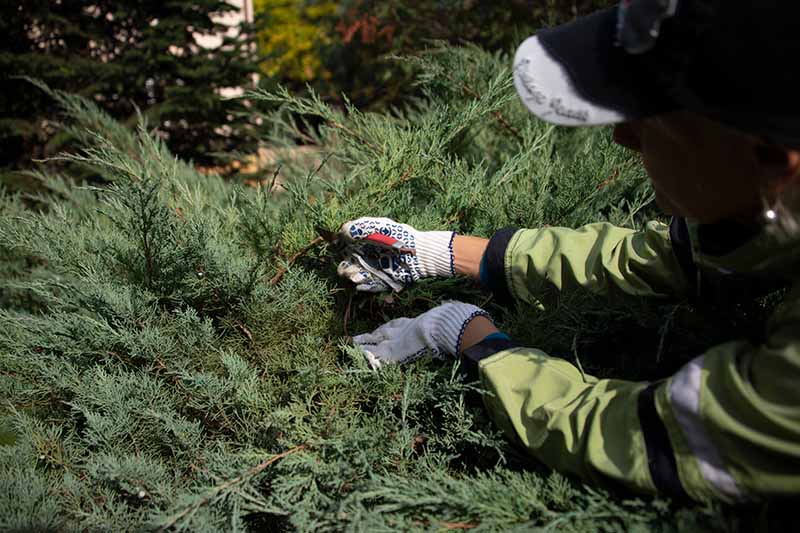Junipers aren’t as forgiving as some plants when it comes to pruning. Do the job the wrong way and you’ll end up with an ugly skeleton of a shrub with bald spots and bare branches.
On the bright side, junipers don’t generally need much in the way of pruning, with a few exceptions.
We link to vendors to help you find relevant products. If you buy from one of our links, we may earn a commission.
While these plants are notoriously low maintenance, when trimming up is necessary, it’s important to do it right. We’ll talk about the how and the when in this guide.
Juniper trees are a popular evergreen landscaping choice thanks to their hardiness interesting foliage, and low maintenance needs. While junipers don’t require much pruning to thrive occasional trimming can help maintain their shape, encourage bushy new growth, and remove dead branches. Knowing when to prune is key to avoiding damage and keeping junipers looking their best.
Why Pruning is Important for Junipers
- Removes dead or damaged branches to improve appearance and prevent disease
- Opens up inner branches to light and air circulation
- Maintains desired size and shape
- Encourages bushy new growth from tips of branches
- Rejuvenates overgrown or neglected plants
Pruning is less about controling size with junipers and more about maintaining their natural shape and getting rid of problem limbs. Junipers don’t respond well to severe pruning and won’t grow back if cut too far. Careful, conservative trimming is best.
When is the Best Time to Prune Juniper Trees?
Junipers can be pruned almost any time except winter but the ideal time is early spring before new growth emerges.
Spring Pruning
Early spring, from late winter to just before spring growth starts, is prime juniper pruning time.
Benefits of spring pruning:
- Leaves plants time to recover before active growing season
- Easier to see shape and structure without foliage
- Avoids damaging tender new spring growth
- Promotes vigorous regrowth as weather warms
March-April is generally the best month for spring juniper pruning in most regions. Prune as soon as plants begin waking up from winter dormancy
Trim back branches by 1/4 to 1/3 of their length to just above a whorl of branches or buds. Avoid cutting into bare wood, only prune to green. This stimulates bushy regrowth from dormant buds near the cut.
Remove dead or damaged branches back to their point of origin on the main trunk. Thinning inner branches also helps with air circulation.
Summer Pruning
Junipers can also be conservatively pruned in summer if needed to maintain shape or remove damaged limbs.
Summer pruning guidelines:
- Stick to minor trimming, don’t remove more than 30% of live foliage
- Never cut emerging spring growth at branch tips
- Prune back to a strong bud or branch junction
- Focus only on correctional pruning, not major reshaping
- Avoid pruning during hot, dry weather
June-July is generally the best time for summer pruning. Pruning too late risks winter damage.
Fall & Winter Pruning
Avoid pruning junipers in fall and winter.
- Fall pruning can lead to winter injury on new growth
- Winter pruning destroys leaves that protect dormant buds from cold damage
- Winter pruning causes high sap loss right before the dormant season
The exception is removing dead or hazardous branches, which can be pruned anytime. But limit live branch pruning to early spring through mid summer.
How Often to Prune Junipers
- Young trees under 5 years old can be pruned 1-2 times per year for training
- Mature junipers are best pruned every 1-3 years to maintain shape
- Overgrown plants may need rejuvenation pruning for 2-3 years
- Neglected, overgrown plants can be renewed by pruning 25% of oldest branches per year
Old or stressed junipers should only be lightly pruned, no more than 15% of live foliage removed annually.
Old, overgrown plants are best replaced rather than trying to renovate through heavy pruning. Junipers don’t react well to renewal pruning.
Tips for Pruning Juniper Trees
- Always sterilize pruning tools before and after on each plant
- Never remove more than 30% of live foliage at one time
- Cut 1/4 in above healthy buds or branch collars
- Avoid shearing; prune individual branches for natural shape
- Remove inward-facing branches and crisscrossing limbs
- Open up center to light by thinning inner branches
- Tie sagging branches to main trunks to correct shape
- Seal cuts over 1 in diameter with pruning sealer
Knowing when to judiciously prune junipers is key to maintaining their health and natural beauty without harming the plants. Follow these juniper pruning guidelines for the best results. Your junipers will reward you with lush new growth, great form, and rustic year-round structure.

The Goal of Pruning Junipers
First, let’s get the bad news out of the way. If you’re hoping to reduce the size of your juniper rather than providing some shape, pruning isn’t going to work very well.
The goal of taking the trimmers to your plant is to encourage bushier growth, remove dead wood, or create some shape. Otherwise, junipers generally don’t need to be pruned at all.

Now, if you want to shape your shrub into a topiary or other formal shape, that’s a different subject. That requires some pretty regular pruning and shaping.
What we’re talking about is rejuvenation pruning of neglected plants with dead branches, or performing routine maintenance.
While we’re on the topic, if you have a bush or tree that is bursting out of its spot or that keeps grabbing you as you try to walk past it on the sidewalk, your best bet is to dig up the plant, transplant it elsewhere, and replace it with something smaller.
Trimming won’t keep it small and the plant will never look as good, nor grow as healthy, as it should.
Some species like boxwoods can be kept smaller through pruning and they’ll still be healthy, but junipers just aren’t one of those plants.
Technically, as long as the temperature isn’t below freezing, you can prune at any time of year. Pruning when it’s below freezing can seriously damage or even kill the plant.
Avoid doing the job in the fall, since this can increase the chance of incurring winter damage.
Early spring or late winter is best. You want to try to break out the secateurs before the tender new growth forms. It’s healthier for the plant and looks better, to boot.
The method you’ll use depends on the size of the branch you are cutting. Small branches that are the same diameter or smaller than a pencil can be snipped with a pair of secateurs, while slightly larger branches can be cut with pruners.
Whichever you use, don’t cut beyond the branch collar. This is a slightly raised spot at the base of where the branch meets the trunk.

Large branches should be trimmed with a saw using a three-step method, as follows.
1. First, saw halfway through the underside of the branch a few inches out from the trunk.
2. The second cut should be made from the top side. About half an inch out from the lower cut, saw down through the branch about halfway at an angle, so you meet your undercut. The whole thing should now come away cleanly.
3. Finally, saw away the remaining stump, taking care not to cut past the branch collar. This prevents the weight of the branch from breaking it off as you cut.
If you trim back a branch beyond where the needles are growing, hoping to encourage branching, it won’t work. Junipers form needles at the green tip of branches, and old wood won’t form new needles.
If you need to trim a branch back past the point where the needles are, remove it entirely.

You should also remove any branch that doesn’t have needles on it. Remember, it will never start growing new foliage.
Regardless of how many branches you remove from the plant, avoid pruning the central trunk, which is known as the leader. A healthy evergreen has one central trunk that the rest of the growth emerges from.
Plants with multiple leaders tend to be weaker and are susceptible to damage from wind and heavy snow. If your plant is young and has more than one central leader, remove all but one of them.
Remember that junipers are slow growers, so don’t prune too much all at once. This is particularly true of plants in growing shadier spots. Anything more than a quarter of the plant at a time is too much to trim.
There’s no need to seal the end of the cuts. The bush will do that itself, with the resin that flows inside the plant.
If your goal is to encourage bushy growth, there are a few things to keep in mind.
First, shearing the plant isn’t the way to go about it. Not only can this create dead spots, but it creates a thick outer layer of foliage that shades the interior.

New foliage emerges from the tips of the branches, so the only way to encourage bushier growth is to trim the young, green ends.
The most natural-looking way to do this is to clip individual green tips with a pair of secateurs rather than shearing the entire plant.
This Method of Pruning Trees will Simplify Everything!
FAQ
What month do you trim junipers?
Junipers and arborvitae generally need little to no pruning. They may be pruned anytime except during sub-zero weather. The best time is early spring prior to new growth.
Why do junipers turn brown?
